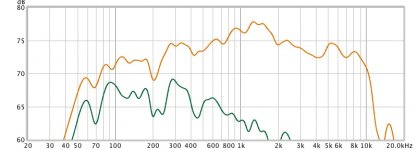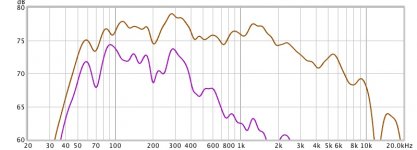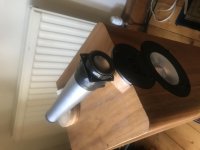Hello,
I’ve been taking a long read of the linkwitz lab pages over the last few weeks and started to obsess over whether I can cheaply test out the omni directional approach without a completely new build.
The idea I have settled on is to take my existing diy loudspeaker project (a 2-way JX92S/ XT19 + minidsp) and add a narrow face-plate wide-range driver on top.
The idea is that due to the narrow faceplate, the wide-range driver will be acoustically small over a good part of its range, resulting in diffraction and a spherical radiation pattern.
The minidsp setup will allow me to easily compare different configurations of the 3 drivers.
I’ve been taking a long read of the linkwitz lab pages over the last few weeks and started to obsess over whether I can cheaply test out the omni directional approach without a completely new build.
The idea I have settled on is to take my existing diy loudspeaker project (a 2-way JX92S/ XT19 + minidsp) and add a narrow face-plate wide-range driver on top.
The idea is that due to the narrow faceplate, the wide-range driver will be acoustically small over a good part of its range, resulting in diffraction and a spherical radiation pattern.
The minidsp setup will allow me to easily compare different configurations of the 3 drivers.
To get omni-directionality over a wide range, the top driver needs to go down to the frequency where the midbass becomes acoustically large.
For horizontal dispersion, this will be dependent on the baffle width.
So somewhere around the point of the baffle-step frequency.
Linkwitz states the boundary between acoustically small and large is a quarter wavelength.
For my loudspeakers, with a 22cm baffle that would be 390Hz
So as a rule of thumb, the top driver would need to crossover to the midbass at 390Hz.
Below that frequency, the midbass is approx omni and above that frequency the top driver will kick-in.
Would be interested in comments. I’ve already made a somewhat controversial choice for the top driver - more to come!
For horizontal dispersion, this will be dependent on the baffle width.
So somewhere around the point of the baffle-step frequency.
Linkwitz states the boundary between acoustically small and large is a quarter wavelength.
For my loudspeakers, with a 22cm baffle that would be 390Hz
So as a rule of thumb, the top driver would need to crossover to the midbass at 390Hz.
Below that frequency, the midbass is approx omni and above that frequency the top driver will kick-in.
Would be interested in comments. I’ve already made a somewhat controversial choice for the top driver - more to come!
You've covered the obvious opportunity with that one, and higher frequencies are more of a challenge. If you look at some omnis they are designed to radiate 360 horizontal, rather than in every direction, and that limitation should simplify your task. Some omnis also use diffraction to achieve their goal.
Thanks AllenB - I think you are right, horizontal omni-directionality will be much simpler.
Here is the design I've started with JX92S/XT19/MLTL before adding the omni driver.
I managed to get some free time this weekend to take some measurements in REW.
top = 0 degree, bottom = 180 degree (rear of speaker), both 40cm distance.
As expected, the 0 degree shows falling response below 1kHz due to diffraction (baffle step) and the 180 degree shows the same diffracted wavefront, but falling above 500Hz. They are not exactly complementary, which surprised me a bit.
I then compensated for the baffle step:

top curve = 0 degree, bottom = 180 degree.
Now the rolloff above 400Hz is clearer.
It more or less matches theory and shows that we now need an omni directional driver above 400Hz.
Here is the design I've started with JX92S/XT19/MLTL before adding the omni driver.
I managed to get some free time this weekend to take some measurements in REW.

top = 0 degree, bottom = 180 degree (rear of speaker), both 40cm distance.
As expected, the 0 degree shows falling response below 1kHz due to diffraction (baffle step) and the 180 degree shows the same diffracted wavefront, but falling above 500Hz. They are not exactly complementary, which surprised me a bit.
I then compensated for the baffle step:

top curve = 0 degree, bottom = 180 degree.
Now the rolloff above 400Hz is clearer.
It more or less matches theory and shows that we now need an omni directional driver above 400Hz.
Driver choice and some maths
The next, more challenging step is the omni driver choice.
I'm strongly influenced by Linkwitz Pluto Linkwitz Pluto which uses a 2 inch Aurasound NSW2
NSW2
For diffraction to work up to the highest possible frequency, the faceplate must be small - for example a 2 inch driver will be acoustically small up to 1.7kHz. Linkwitz claims omnidirectionality up to 3kHz for the Pluto - did I get the maths wrong?
However, a 2 inch driver will be limited at low frequencies.
From what (I think) I know, the parameters in questions are:
Xmax - maximum linear excursion of the driver, in this case +/- 3mm for the Aurasound
Fc - minimum frequency we want the driver to operate, in this case 400Hz
Sd - radiating area, in this case 13.2cm-sq
Distortion - to be measured
Power handling - 15W RMS
As these parameters can feel a bit arbitrary, I've attempted to compare some of them to the midbass driver I'm using (Jordan JX92S) to find out whether excursion will be an issue.
First of all radiating area:
Midbass JX92S Sd = 78.5cm-sq, Omni NSW2 Sd = 13.2cm-sq
Sd ratio = 78.5/13.2 = 6
Now taking into account excursion:
Midbass JX92S Xmax = +/4.5mm
Omni NSW2 Xmax = +/3.3mm
X ratio = 4.5/3.3 = 1.36
So, the JX92S can can product 6x1.36 = 8x the sound pressure at a give frequency. That's 18dB.
However, we are only requiring the NSW2 to work down to 400Hz.
Excursion is inversely proportional to the square of the frequency. So, reworking the maths means that NSW2 can produce the same SPL at 400Hz as the JX92S can at 400/sqrt(8) = 140Hz.
(To look at the maths another way, excursion drops 12dB/octave with increasing frequency, so the JX92S can produce the same SPL 1.5 octaves below the NSW2)
Since in the design I am using, the JX92S covers a range much lower than 140Hz, it will excursion limit well before the NSW2.
This say to me, that, on paper at least, the excursion limit and cone area of the NSW2 are not the limiting factor.
The next, more challenging step is the omni driver choice.
I'm strongly influenced by Linkwitz Pluto Linkwitz Pluto which uses a 2 inch Aurasound NSW2
NSW2
For diffraction to work up to the highest possible frequency, the faceplate must be small - for example a 2 inch driver will be acoustically small up to 1.7kHz. Linkwitz claims omnidirectionality up to 3kHz for the Pluto - did I get the maths wrong?
However, a 2 inch driver will be limited at low frequencies.
From what (I think) I know, the parameters in questions are:
Xmax - maximum linear excursion of the driver, in this case +/- 3mm for the Aurasound
Fc - minimum frequency we want the driver to operate, in this case 400Hz
Sd - radiating area, in this case 13.2cm-sq
Distortion - to be measured
Power handling - 15W RMS
As these parameters can feel a bit arbitrary, I've attempted to compare some of them to the midbass driver I'm using (Jordan JX92S) to find out whether excursion will be an issue.
First of all radiating area:
Midbass JX92S Sd = 78.5cm-sq, Omni NSW2 Sd = 13.2cm-sq
Sd ratio = 78.5/13.2 = 6
Now taking into account excursion:
Midbass JX92S Xmax = +/4.5mm
Omni NSW2 Xmax = +/3.3mm
X ratio = 4.5/3.3 = 1.36
So, the JX92S can can product 6x1.36 = 8x the sound pressure at a give frequency. That's 18dB.
However, we are only requiring the NSW2 to work down to 400Hz.
Excursion is inversely proportional to the square of the frequency. So, reworking the maths means that NSW2 can produce the same SPL at 400Hz as the JX92S can at 400/sqrt(8) = 140Hz.
(To look at the maths another way, excursion drops 12dB/octave with increasing frequency, so the JX92S can produce the same SPL 1.5 octaves below the NSW2)
Since in the design I am using, the JX92S covers a range much lower than 140Hz, it will excursion limit well before the NSW2.
This say to me, that, on paper at least, the excursion limit and cone area of the NSW2 are not the limiting factor.
If you put a bass driver on the back, or even four around a squared cabinet you could use it higher. This would also help with the extra excursion needed.
What are you using diffraction for in this case?For diffraction to work up to the highest possible frequency,
Hi Allen, my setup looks like this currently

I’m using diffraction to create an omni directional pattern from the 2” driver at the top, covering 400Hz to 2kHz, at least that’s the theory.
This is intended as an add-on to the existing design, without cabinetry.
True, additional drivers might help, though it could get quickly get out of hand...

I’m using diffraction to create an omni directional pattern from the 2” driver at the top, covering 400Hz to 2kHz, at least that’s the theory.
This is intended as an add-on to the existing design, without cabinetry.
True, additional drivers might help, though it could get quickly get out of hand...
Hello,
I’ve been taking a long read of the linkwitz lab pages over the last few weeks and started to obsess over whether I can cheaply test out the omni directional approach without a completely new build.
The idea I have settled on is to take my existing diy loudspeaker project (a 2-way JX92S/ XT19 + minidsp) and add a narrow face-plate wide-range driver on top.
The idea is that due to the narrow faceplate, the wide-range driver will be acoustically small over a good part of its range, resulting in diffraction and a spherical radiation pattern.
The minidsp setup will allow me to easily compare different configurations of the 3 drivers.
Years ago, I made a mixed cardioid by combining a Tymphany full range with a SB Acoustics 2.5" full range running dipole on top of it.
It worked pretty well: Sealed vs Dipole vs Cardioid | Page 4 | DiyMobileAudio.com Car Stereo Forum
Same idea as Kimmo Saunisto's mixed cardioid.
Thanks Patrick - interesting idea! I have to confess, I don’t yet understand the relative merits of different loudspeaker polar patterns. What I like about your approach, is that you can create different polar patterns by changing the relative gains of the two drivers.
I’ve seen this approach used for directional microphones e.g mixing a figure-of-eight with an omni, to create cardioid, hypercardiod etc.
I’ve seen this approach used for directional microphones e.g mixing a figure-of-eight with an omni, to create cardioid, hypercardiod etc.
- Home
- Loudspeakers
- Multi-Way
- Omni direction cheat